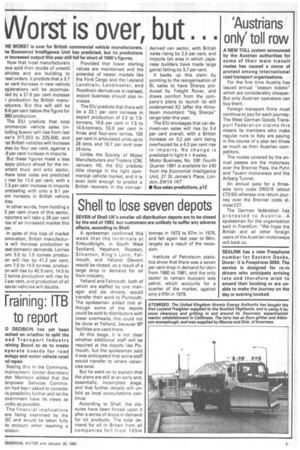Worst is over, but
Page 5

If you've noticed an error in this article please click here to report it so we can fix it.
'HE WORST is over for British c he Economist Intelligence Unit Dr increased output this year still Now that most manufacturers aye sold their stocks of unsold ehicles and are building to 1o:eat orders, it predicts that a 3.7 ,er cent increase in new vehicle egistrations will be accompaied by a 27.8 per cent increase
production by British menu3cturers. But this will still be 6.8 per cent below the figure for 980 production.
The EIU predicts that total ommercial vehicle sales (inluding buses) will rise from last ear's 217,903 to 225,500, and let British vehicles will increase ales by four per cent, against a .9 per Cent increase in imports. But these figures mask a less appy picture ahead for the imortant truck and artic sector, /here total sales are predicted ) rise by 13.6 per cent, with a 7.3 per cent increase in imports ontrasting with only a 9.1 per ant increase in British vehicle ales.
In other words, from holding a 5 per cent share of this sector, nporters will take a 28 per cent lice of an increased market this ear.
In spite of this loss of market omination, British manufacturrs will increase production to meet domestic demands. Lorries om 3.5 to 7.5 tonnes producon will rise by 41.2 per cent, om 7.5 to 14.5 tonnes, producon will rise by 42.9 cent, 14.510 5 tonne production will rise by 5 per cent, and production of all eavier vehicles will double. omrnercial vehicle manufacturers, has predicted, but its predictions fall far short of 1980's figures.
Provided that lower sterling values are maintained and the potential of newer models like the Ford Cargo and the Leyland Landtrain, Landmaster, and Roadtrain derivatives is realised, export business should also increase.
The EIU predicts that there will be a 23.1 per cent increase in export production of 3.5 to 7.5tonners, 16.6 per cent in 7.5 to 14.5-tonners, 53.8 per cent in three and four-axle lorries, 100 per cent in articulated units up to 28 tons, and 16.7 per cent over 28 tons.
Unlike the Society of Motor Manufacturers and Traders (CM, January 16), the EIU predicts little change in the light commercial vehicle market, and it is even bold enough to predict a British recovery in the non-car derived van sector, with British sales rising by 2.5 per cent, and imports (an area in which Japanese builders have made large gains) falling by 3.7 per cent.
It backs up this claim by pointing to the reorganisation of BL sales to have Sherpa produced by Freight Rover, and draws comfort from the company's plans to launch its still codenamed K2 (after the Himalayan mountain) "big. Sherpa" range later this year.
The EIU envisages that car-derived-van sales will rise by 3.4 per cent overall, with a British increase on 3.2 per cent being overhauled by a 4.3 per cent rise in imports. No change is predicted in light 4 x 4 sales.
Motor Business, No. 108: Fourth Quarter 19811s available for £40 from the Economist Intelligence Unit, 27 St James's Place, London, SW1A INT • Bus sales predictions, p12
























































